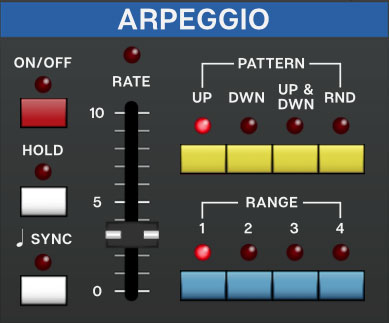
An arpeggiator is basically a step sequencer that plays each note of a chord individually in an ascending or descending pattern across one or more octaves. Though the original Juno-106 synth did not have any arpeggiator, the The DCO-106 Arpeggio section closely replicates the functionality of the Juno-6/Juno-60.
On/Off- Enables and disables the Arpeggio section.
Rate- Sets the rate of the arpeggiator.
Pattern- These buttons select the order in which the notes of the chord will be played. Up plays the notes in order from lowest to highest, Dwn from highest to lowest, Up&Dwn will play the notes from lowest to highest then back to lowest again (the highest and lowest note will be played twice in a row) and Rnd will randomly cycle through notes.
Range- Selects how many octaves the pattern will play before repeating.
Hold- When engaged, arpeggios continue to run without having to continuously hold down keys. This allows you to play a series of chords without the arpeggiator stopping as keys are released. Be aware that it will not stop until you disengage the button again. Mapping this to a sustain pedal or button on a MIDI controller can be useful for conveniently toggling this on and off.
Sync- Engaging the Sync button locks arpeggio timing to master tempo. When engaged, the Rate slider snaps to note values ranging from 1/64th note triplet to 8 beats. Sync mode locks to the tempo in the top toolbar when using the DCO-106 standalone version or the current project tempo when the plug-in version is used in a DAW.